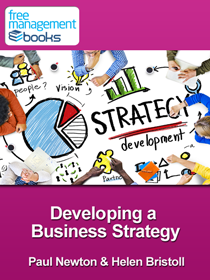Developing a Business Strategy - Free eBook in PDF Format
 |
 |
|
Book Description - ISBN 978-1-54345-823-6 (39 Pages)
This free eBook describes five contemporary organizational development techniques and models. You can use these to help you develop a strategy for your organization.
Chapter 1 - The EPG Model
Maintaining the focus and direction of international organizations is especially fraught as there is a tendency to take on too much. The EPG model allows the organization to remain focused on its core values and culture so that it thrives. It helps to align the ‘strategic profile’ of the organization with what it’s trying to accomplish, trouble will likely be soon to follow. This strategy tool assesses an organization from the different principles – Ethnocentrism, Polycentrism and Geocentrism.
Chapter 2 - The Greiner Curve
Challenges and crises are inevitable over time as organizations adapt in order to expand and thrive. The Greiner Curve is divided into six phases along its growth path and enables organizations to handle the challenges in a productive and positive manner as they occur. Organizations that are not aware of this strategy tool can find themselves stopped in their tracks at any one of the points along the growth curve.
Chapter 3 - Adizes’ Corporate Lifecycle
Organizations move through a lifecycle that whilst unpredictable does have certain characteristics that are shared from company to company. Dr. Ichak Adizes defined the 10 unique stages in the lifecycle of a corporation. The ‘Prime’ is the ideal stage that every organization needs to strive for and aim to remain in it for as long as possible.
Chapter 4 - Deming’s Five Diseases of Management
Professor Deming recognized some of the most-common problems that threaten an organization and referred to them as ‘the Five Diseases of Management’. They are lack of constancy of purpose, emphasis on short-term profits, annual rating of performance, mobility of management and the use of visible figures only. His strategy tool helps an organization identify its own ‘state of health’ in relation to each of these ‘diseases’ and assess the extent of threat it represents to the organization.
Chapter 5 - The Pyramid of Organizational Development
Successful organizations are structured in a way that facilitates their growth and development. The Pyramid of Organizational Development is a strategy tool that helps prevent poor structure being created or perpetuated. It has six areas market, products and services, resources management, operational systems, management systems and corporate culture. The most successful organizations are continually reviewing their operational processes and strategies to ensure the development of their organization ensures success.
| You will learn: |
|
![]()
![]()
What is the EPG Model?
- The EPG model is a framework for a firm to better pinpoint its strategic profile in terms of international business strategy.
- The model states that a multinational organisation holds one of three orientations at any point in time:
- Ethocentric orientation is where the organization’s senior management believe that nationals from the organisation’s home country are more capable to drive international activities forward than non-native employees.
- Polycentric orientation assumes that host country cultures are different making a centralised approach unfeasible.
- In Geocentric orientation nationalities are largely ignored, with the company being run as a global enterprise rather than a large corporation which is deeply rooted in one specific nation.
- The model suggests that most multinationals start out with an ethnocentric view, evolve to polycentrism and finally adopt geocentrism.
- The EPG Model provides insight in how far an organisation has internationalised.
What is the Greiner Curve?
- The idea behind the Greiner Curve is that there are inevitably going to be challenges, or ‘crises’, that arise over time as an organization grows.
- Greiner suggested that businesses underwent six distinct phases as they grew, each precipitating a crisis at which a revolution in thinking and approach was required to progress to the next stage.
- Growth through creativity. During this phase business owners will communicate with customers and react to their demands. This phase is brought into crisis by the need for professional management.
- Growth through direction. During this phase the new leadership team will start to steer the business while a new tier of management is put in to deal with specific functions of the business. This phase ends with lower level management requiring more autonomy and involvement in decision making.
- Growth through delegation. This phase comes into crisis as the executive feels like it is losing control over the lower tiers of management.
- Growth through co-ordination. The necessary bureaucracy that this phase entails leads to resentment from both higher and lower tier management as procedure stifles creativity and autonomous problem solving.
- Growth through collaboration. There are limits to all businesses when they only stick with what it is they do in house. This phase ends with a crisis of identity as further growth becomes possible only through alliances with external organisations.
- Growth through Extra-Organizational Solutions. Finding ways to work with other organizations so that the core of the original business is not affected will be challenging, but potentially very rewarding.
- Developing an understanding of why periods of growth can quickly precipitate a crisis can give you an appreciation of why businesses sometimes fail even when seeming outwardly to be successful.
What is Adizes’ Corporate Lifecycle?
- Corporate lifecycles are not perfectly predictable, although they do have certain characteristics that are shared from company to company and undergo predictable and repetitive patterns of behavior as they develop.
- How well management leads a healthy transition from one stage to the next, has an impact on the success or failure of the organization.
- Changes in leadership and management are required because methods that produce success in one stage can create failure in subsequent stages.
- It is never easy to sustain success, but understanding how the lifecycle works can help you to watch out for risks and hazards to your organization as it moves from one stage to the next.
What is Deming’s Five Diseases of Management?
- In Deming’s Five Diseases of Management, some of the most-common problems are identified and assessed.
- Lack of Constancy of Purpose – One of the common mistakes made by management is not clearly understanding exactly what it is they are in business for in the first place.
- Emphasis on Short Term Profits – When choices are made only based on how to maximize short term profits the long term health of the company is compromised.
- Annual Rating of Performance – Instead of making decisions and taking actions that are best for the company, employees are forced to look out for their own self-interests by going things that will review well when the time comes.
- Mobility of Management – The organizations who receive the best results from their management team tend to be those who keep managers around for as long as possible, and those who don’t reward those managers only for short term progress.
- Use of Visible Figures Only – Some things that aren’t measurable, such as positive customer service, can create long term benefits that might not be seen in the here and now.
- An experienced management team will understand the need to keep an eye on the long term future rather than simply the short term results that show up on things like quarterly reports.
What is the Pyramid of Organizational Development?
- The Pyramid of Organizational Development consists of six factors that research has shown to be the key drivers of financial performance and long-term organizational success.
- Market: There has to be a market of willing buyers that not only exists, but exists in a large enough quantity to sustain the underlying business.
- Products and Services: These are appropriate to the organization’s chosen market.
- Resource Management: This includes the acquisition and development of people, equipment, facilities, and financial resources required for current and future operations.
- Operational Systems: These are necessary for the organization to function on a day-to-day basis.
- Management Systems: These include strategic planning, organizational structure, leadership development, and performance management systems.
- Corporate Culture: The organization’s values, beliefs, and norms that influence the behavior of people in the company.
- The Pyramid of Organizational Development can be used to identify an organization’s strengths and opportunities to improve.


